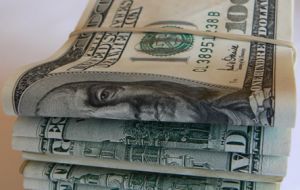MercoPress. South Atlantic News Agency
While the world rejects flood of dollars, in Argentina it’s a ‘flight to safety’
 Don’t blame Argentines if they feel safer in dollars than in Pesos
Don’t blame Argentines if they feel safer in dollars than in Pesos While in the rest of South America governments are trying to make the inflow of US dollars more difficult in Argentina the greenback is in great demand as the coming presidential election has triggered a solid “flight to safety”.
According to the latest estimates so far, 2011 could mark a record flight, similar or even higher than in 2008, when the world financial crisis officially took off and the Argentine government faced a long standing conflict with farmers which forced the cash-strapped administration of President Cristina Fernandez to take over the private pension funds.
Private statistics show that in the first half of the year 10.1 billion dollars left Argentina and at this rate could have reached 11.4 billion dollars at the end of July. In the record year of 2008, an estimated 23.1 billion dollars fled Argentina.
In 2007 when the beginnings of the sub-prime crisis in the US and the Argentine presidential electoral process, an estimated 8.8 billion dollars left the country; in 2009 the figure was 14.1 billion coinciding with global recession and legislative elections.
In a recent paper presented at the Austral University Business School, economist Carlos Melconian marked the differences between the current flight to safety process and that of previous years. While in 2007, two thirds of dollar funds belonged to major operators, the rest were small holders.
In 2009 and 2010, the spilt was 50%/50%, while this year, 80% of dollar purchases are done by small holders and depositors. This has forced banks to increase rates on Argentine pesos as depositors move to US dollars.
However Melconian and most Argentina economist argue there is no financial or exchange rate crisis in the short term “or round the corner”, but the flight to the dollar is consolidating as a tendency. “People feel safer if they keep to dollars instead of Argentine pesos”.
But there are questions, since 2011 is not as previous years that enjoyed a comfortable trade surplus and lower inflation rate. “People are asking how long the Argentine government can keep the Peso virtually flat with a 25% annual inflation and a flood of manufactured imports benefiting from the strong Argentine currency”.
In effect imports are soaring in Argentina mainly because of the purchase of energy and fuel, and the trade surplus estimate for 2011 is 9 billion dollars when the average in previous years stood at 12 billion.
“It is also evident that with the current exchange rate the Argentine economy indicators are moving towards a less comfortable situation; pressures are mounting and there are expectations as to how the new government (December 10) will address them”, points out the report.
Melconian believes that in the next twelve months Argentina will enjoy sufficient ‘farm-dollars’, which is a guarantee against a crisis. But mounting pressure on the dollar, could lead the next government to establish a transition system of multiple exchange rates.
Another ‘fear’ factor mentioned are statements from some of President Cristina Fernandez administration officials who anticipate in the next mandate a ‘deepening’ of the current model to include a greater take of companies’ profits and government delegates in the major private sector corporations. Economy Deputy Secretary Roberto Feletti is indicated as the man who has publicly defends such policies.
Finally a private bank from Buenos Aires city points out that uncertainties in the foreign exchange market have made further accumulation of international reserves by the Argentine central bank “difficult”. Reserves remain at their end-of-2010 level at 52 billion dollars besides the fact that on some weeks the bank has been forced to sell (up to 400 million dollars) to keep the rate relatively flat. In spite of these efforts the Argentine peso managed to appreciate 0.7% against the dollar in July, according to private estimates.




Top Comments
Disclaimer & comment rules-

-

-

Read all commentsthese are all routine fluctuations...
Aug 04th, 2011 - 09:14 am 0the Peso is more safer than - $ - nowadays ..
I wouldn't see it that way... the argentinian peso has a hidden convertbility to the US Dollar and a steady but clear and stable devaluation toward the dollar. No matter how strong the fluctiations of the dollar are in the world, the relation to the peso is always stable.
Aug 04th, 2011 - 11:28 am 0If you had to judge the dollar by the relation to the peso, one would think, the dollar is the most stable currency in the world.
20B/yr leaving the country? Why would that happen if it has the strongest growth in SA? Methinks someone is fibbing could it be CFK through INDEC? Could it be growth isn't really 9.8% but really 4% or inflation is 30% not 9%? Just changing those two variables what does that do to the real poverty %? Hmmm no wonder the $ is flying out as fast as it is being made.
Aug 04th, 2011 - 12:01 pm 0BTW you can't get rid of your ARG Pesos once you leave the country nobody will exchange them you might as well throw them away. Plus Argies still prefer to get U$ from tourists the street exchange rate is +/-$4.60!
Commenting for this story is now closed.
If you have a Facebook account, become a fan and comment on our Facebook Page!